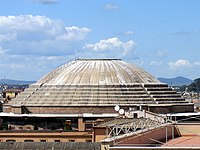
Photo from wikipedia
Aging is inevitable when biochar uses for remediate Cadmium (Cd) pollution, but the variation of adsorption mechanism remains unclear. This study uses ramie residue to prepare fresh biochar, and adopt… Click to show full abstract
Aging is inevitable when biochar uses for remediate Cadmium (Cd) pollution, but the variation of adsorption mechanism remains unclear. This study uses ramie residue to prepare fresh biochar, and adopt it with acidification and oxidation to simulate the aging process. The difference of physicochemical properties between fresh and aged biochar are studied through microstructure. Then, two kinds of biochar are making adsorption experiments in Cd solution for analyzing their adsorption mechanism. The results show that, both chemisorption and physisorption are exist, chemisorption and physisorption is the predominant way of fresh biochar and aged biochar respectively. Cation exchange is important but weaker in aged biochar than fresh biochar. Carboxyl plays a leading role in complexation of fresh biochar and hydroxy in aged biochar. Coprecipitation and cation-π mechanism impair apparently in aged biochar. This study indicates that aging change ramie biochar's main adsorption mechanism and the primary chemisorption way.
Journal Title: Bioresource technology
Year Published: 2021
Link to full text (if available)
Share on Social Media: Sign Up to like & get
recommendations!